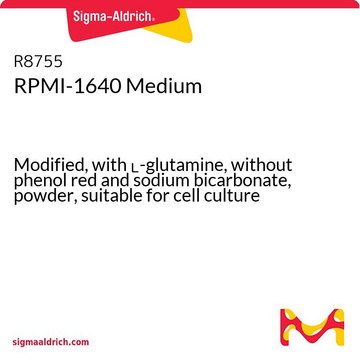R0883
RPMI-1640-Medium
With sodium bicarbonate, without ʟ-glutamine, liquid, sterile-filtered, suitable for cell culture
Synonym(e):
Roswell Park Memorial Institute 1640 medium
About This Item
Empfohlene Produkte
Produktbezeichnung
RPMI-1640-Medium, With sodium bicarbonate, without L-glutamine, liquid, sterile-filtered, suitable for cell culture
Sterilität
sterile-filtered
Form
liquid
Methode(n)
cell culture | mammalian: suitable
Verunreinigungen
endotoxin, tested
Komponenten
sodium pyruvate: no
phenol red: yes
L-glutamine: no
NaHCO3: yes
HEPES: no
Versandbedingung
ambient
Lagertemp.
2-8°C
Suchen Sie nach ähnlichen Produkten? Aufrufen Leitfaden zum Produktvergleich
Allgemeine Beschreibung
Anwendung
- zum Kultivieren der PC-3-Prostatazelllinie und von Jurkat-Zellen
- zum Erhalten der dreifach negativen MDA-MB-231- und einer humanen kaukasischen MCF7-Brustadenokarzinomzelllinie vom luminalen Typ
- zum Kultivieren von zirkulierenden Tumorzellen (CTC)
Rekonstituierung
Ergänzung
auch häufig zusammen mit diesem Produkt gekauft
Lagerklassenschlüssel
12 - Non Combustible Liquids
WGK
WGK 2
Flammpunkt (°F)
Not applicable
Flammpunkt (°C)
Not applicable
Hier finden Sie alle aktuellen Versionen:
Besitzen Sie dieses Produkt bereits?
In der Dokumentenbibliothek finden Sie die Dokumentation zu den Produkten, die Sie kürzlich erworben haben.
Kunden haben sich ebenfalls angesehen
Protokolle
WST-1 assay protocol for measuring cell viability, proliferation, activation and cytotoxicity. Instructions for WST-1 reagent preparation and examples of applications. Frequently asked questions and troubleshooting guide for WST-1 assay.
Protocol Guide: XTT Assay for Cell Viability and Proliferation
Unser Team von Wissenschaftlern verfügt über Erfahrung in allen Forschungsbereichen einschließlich Life Science, Materialwissenschaften, chemischer Synthese, Chromatographie, Analytik und vielen mehr..
Setzen Sie sich mit dem technischen Dienst in Verbindung.








